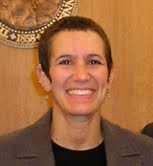
The field of interpreting evolves rapidly; bridging the gap from educational programs to real-world interpreting is critical. Rico Peterson shares critical components from RIT/NTID’s DAS Apprenticeship program.
A while ago I taught a workshop in Thailand. My driver, Tuy, took pains during our commute to describe points of interest and cultural nuance. At stoplights, vendors would rush into the queue of cars. One day, Tuy bought a small garland. As he fixed the flowers to his rearview mirror, he explained, “Respect for the car and for the road. It’s important to respect where we’re going and how we’re getting there.”
On the cusp of this new academic year, those words ring truer than ever.
Recalibrating Pedagogy
Those who taught sign language and interpreting in the days before technology remember a very different pedagogy than that which has developed since, a pedagogy borne largely by technology. You might say that we have seen interpreting education grow from pre-video to meta-video.
Perhaps the biggest constant in this time of change has been video technology and how it continues to impact our field. Technology and the ready availability of cassette recording revolutionized interpreter education in the 1980s. We discovered quickly what a handy tool video could be in teaching and learning interpreting.
Technology in the 21st century has turned the tables. Since 2002, video has learned what a handy tool interpreters can be. As the revolution rolls on, pedagogy recalibrates to consider a new model of sign language interpreting, one where some of the most fundamental precepts of our work are radically different from those we espoused as recently as 2005; where values like professional authority, publicly known standards, and adherence to a code of ethics are superseded by company policy, private, proprietary standards, and selective application of a code of ethics.
Real-World Approximation
In the days before widespread, curricularized interpreter education, people came into our field armed with resources. Language competency, at least as reckoned in ASL, was determined before one was “invited” to interpret. (Granted, this “invitation” betimes felt more compulsory than invitations often do.) Interaction in the source and target languages was available in abundance. Opportunities to work in real-world settings were offered in bite-size chunks. A simple phone message here or appointment made there, done successfully, was fundamental to expanding one’s repertoire into more complex discourse settings. The study of moral conduct was fairly transparent. One needed to behave appropriately to be accepted into the larger deaf/interpreting community. Local communities were adept at policing themselves, endorsing only those with proven fluency and values as “approved” interpreters.
What can apprenticeships today glean from this aboriginal learning environment?
The Challenge
Today students in our sign language interpreting programs are often novice signers, and rarely do they have anything approaching ready contact with both source and target languages. This is a circumstance peculiar to sign language interpreting education. A good deal of what we call Interpreting Education might also be described as “Advanced ASL” or “Advanced English”. In doing some research several years ago, I identified a university that offered programs in both spoken and signed interpretation. Regarding language competence, the exit requirements for the sign language interpreting program were lower than the entrance requirements for the spoken language programs! It is commonly accepted that “Advanced ASL” is a major component of many sign language interpreting programs.
To be sure, the study of “Advanced ASL” contains as many questions and perplexities as the study of “for-profit interpreting”. Again the issue arises — How best to equip novices with experience that will prepare them to enter our rapidly evolving field?
Practice Profession
Interpreting is frequently referred to as a “practice profession”. Definitions for “practice profession” are sprinkled liberally with concepts long known to adherents of “Situated Cognition” and “Experiential Learning”; including things like cognition in context, that knowing and doing are interwoven, and interaction with communities of practice. In both domains it is stipulated that exposure to real work in real settings is fundamental to mixing and refining the palette of skills interpreting requires.
The value of experiential learning or, as we call it, “apprenticeship” in interpreting is as well understood as it is little available. Each year, the 130 IEPs in this country graduate roughly 1000 students. The lack of opportunities for graduates of interpreting programs to be supported as they take their critical early steps down the path toward becoming interpreters has been heard time out of mind in interpreting education.
A number of entities have recognized and rushed to remedy this lacuna, this crucial gap in interpreter education. Indeed, opportunities today are more available than ever for this sort of transitive assistance. Entire communities and regions have come together to offer mentorship programs. One video relay vendor in particular is commendable for its attention to interpreter education.
Critical Program Components
At the Department of Access Services (DAS) at RIT/NTID, we define apprenticeship as a guided entry into the craft and trade of sign language interpreting. The question of what an apprenticeship in interpreting ought include is a central consideration of any program. As apprenticeships take place in real-world settings, who we are and what we do is fundamental.
Here, then, are some of the core components of the DAS program that I think can be valuable to apprentices and programs supporting interpreters:
- Varied venue:
It is critical that programs offer a diversity of settings for their apprentices to work. At DAS we have found that while we are steeped in postsecondary education, academic interpreting, we can expose apprentices to everything from medical to legal (student disciplinary) to student government and life and professional development for the 100+ deaf faculty and staff. The greater the exposure, the more rich the apprentice experience. The more rich the experience, the better the outcomes in the real world.
- Quality working conditions:
The ratio of interpreting time to preparation time is an essential factor in postsecondary interpreting. Again, using DAS as a backdrop, we build interpreting schedules on a ratio of approximately 2:1 in terms of “interpreting” time and rest, recovery, preparation, professional development time. While this may be a high bar in the field of sign language interpreting, we are committed to affording our staff interpreters the time and resources necessary to produce work of the highest quality.
- Professional development activities:
Regular access to in-service trainings, workshops, and learning experiences offers an opportunity to reinforce aspects of our practice. While the amount of professional development can certainly vary, at DAS we have offered over 60 professional development opportunities for our staff of 125 interpreters in the last two years alone. Increased opportunities for reinforcement supports a more confident interpreter in practice.
- Peer to peer mentoring:
Innovation is key to a program’s success. As an example of program innovation, beginning in the spring of 2012, DAS staff interpreters have been offered state-of-the-art mentorship training that allows us to explore new and exciting aspects of mentorship, including assessment and self-assessment.
- Veteran Staff:
The level of experience of a program’s staff may be the most valuable part of apprenticeship. The practical experience offered to support the navigation of ethical and practicing situations is highly valuable to those graduates transitioning into practice. An example of the value a program can bring, DAS employs over 120 full time interpreters who have an average tenure of 13.5 years.
Apprenticeship is Not For Everyone
To be sure, not every student graduating from an IEP wants or needs an apprenticeship. Many students graduate and go directly to work. However, it has been my experience that just as many can benefit from a structured, supported transition from being a student to being an interpreter, one that takes familiar elements of interpreter education like rubrics and self-assessment and blends them into a vibrant experiential learning environment.
Conclusion
The pedagogy of interpreting education must keep pace with the evolution of interpreting practice. DAS’s new apprenticeship program represents an honest offer to improve the way we bring new people into the work we love. And as Tuy once said, it’s important to respect where we’re going and how we’re getting there.



 Tamar is a student in Gallaudet University’s Ph.D. in Interpretation program (pedagogy/research) as well as an adjunct professor for the Department of Interpretation. Tamar enjoys and values presenting and writing about interpreting to promote growth, development, and respect of the interpreting profession. Tamar has worked as a certified community interpreter, mentor, ER on-call manager & interpreter, VRI & VRS interpreter. She enjoys time with her family, state fairs and sunshine.
Tamar is a student in Gallaudet University’s Ph.D. in Interpretation program (pedagogy/research) as well as an adjunct professor for the Department of Interpretation. Tamar enjoys and values presenting and writing about interpreting to promote growth, development, and respect of the interpreting profession. Tamar has worked as a certified community interpreter, mentor, ER on-call manager & interpreter, VRI & VRS interpreter. She enjoys time with her family, state fairs and sunshine.